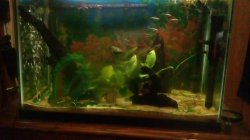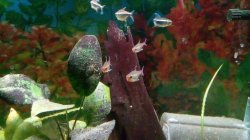cowgirluntamed
Fish Herder
(Dumb tablet!! I had to plug it in in the middle of my post and lost everything!! Ok...second try!)
This is basically of going to be a journal of how I battle green spot algae(the least worrisome), bba, a tiny bit of hair algae, and the most worrisome, cyanobacteria.
My tank stats: 20 gallon high. Temp is 77f. pH is 8.2. gh is 13. Kh is 11. Ammonia and nitrites are 0 and nitrates are normally around ten or so. I have a SunSun canister filter that I just drilled holes in the spray bar to lessen the flow and I just added the intake sponge as well(which unfortunately has to sit on the sand as no matter how I tried...the pieces would fit higher up.) I also have a fluval aquasky light. Current inhabitants are 3 glowlight tetras(will up their numbers when they move to a bigger tank I'm working on) and 7 black neon tetras.
Anyway, this battle started a few months ago I think? I believe the first thing I got was the bba in the back glass and on the anubias nangi that is directly under the light. It is also in the spray bar. I put in some water lettuce and water sprite. Things seemed ok though the water sprite didn't make it(arrived badly). So the guy sent me more water sprite and I also got some crypt retrospiralis. I also took some dwarf sag and crypt wendtii from another tank and added it in. When I did this, I used two flourish root tabs for the two groups of retrospiralis and I added aqueon liquid plant food.
After this is when I got hair algae galore. So I didnt use this fertilizer anymore and the hair algae started to go away, though now I still have a bit but it's not taking over anything.
So I came on here for advice when the bba also started to get a bit worse and I noticed some cyanobacteria starting. That's when I started to learn more about the light and nutrient balance. My light had been set for ten hours on. The white light was full intensity and I don't remember what the red, green, and blue lights were set to. But...my first experiment was to change the light settings. I now have it set for 8 hours on. The white light is 2 notches down from my highest intensity. The red and blue lights are fully in and the green is only a little bit on.
Well, the bba isn't spreading as much but is still there. I also how get green spot algae in the glass. And the cyanobacteria is trying to take over.
Now, another tidbit. I'm bad about water changes. So if I would have done more I think things might not have gotten to where it is now. Maybe. I am going to start doing water changes(and I may do a couple small ones a week to see if I can take care of this cyanobacteria).
I'm hoping that with regular water changes I can keep some of the algae and such at bay, and maybe my plants will start to grow again.(they've been suffering...except the crypt wendtii.) Oh, and I am on well water and I am not going to be using conditioner.
I also switched foods today. I was feeding seachem nutridiet tropical flakes which has too many fillers since I learned about foods. Maybe this could have been contributing to organics or waste. I just got omega one tropical flakes so we'll see how that goes. I also have two days a week I give hikari freeze dried daphnia, blood worms, tubifex worms, or spirulina brine shrimp.
I'm hoping to that I won't need any liquid ferts. I'm going to wait and see if the water changes might perk the plants up. If that doesn't work, then maybe I will try something else. I'm also going to get some Malaysian trumpet snails since I have a sand substrate. Whether they help with some if my possible extra organics or not(from plants dying) I do think they will be beneficial to this tank. Eventually I plan on adding nerites for more of a clean up crew.
Anyway, I have a before and after video along with a few pictures I want to share. If anybody has any ideas on how to battle this stuff(without chemicals preferably) then please let me know. I will try to keep this updated somewhat on what seems to be responding and what doesn't. Water changes right now are going to be my next step. I'm leaving the light as is as the moment.
Oh, and the video and pictures aren't even 24 hours apart yet...
https /youtu.be/uuq5j9SzN8c
/youtu.be/uuq5j9SzN8c
https /youtu.be/elqSNjHNPNM
/youtu.be/elqSNjHNPNM


Just a close up I got of my glowlights...they wanted to say hi! Lol.

This is basically of going to be a journal of how I battle green spot algae(the least worrisome), bba, a tiny bit of hair algae, and the most worrisome, cyanobacteria.
My tank stats: 20 gallon high. Temp is 77f. pH is 8.2. gh is 13. Kh is 11. Ammonia and nitrites are 0 and nitrates are normally around ten or so. I have a SunSun canister filter that I just drilled holes in the spray bar to lessen the flow and I just added the intake sponge as well(which unfortunately has to sit on the sand as no matter how I tried...the pieces would fit higher up.) I also have a fluval aquasky light. Current inhabitants are 3 glowlight tetras(will up their numbers when they move to a bigger tank I'm working on) and 7 black neon tetras.
Anyway, this battle started a few months ago I think? I believe the first thing I got was the bba in the back glass and on the anubias nangi that is directly under the light. It is also in the spray bar. I put in some water lettuce and water sprite. Things seemed ok though the water sprite didn't make it(arrived badly). So the guy sent me more water sprite and I also got some crypt retrospiralis. I also took some dwarf sag and crypt wendtii from another tank and added it in. When I did this, I used two flourish root tabs for the two groups of retrospiralis and I added aqueon liquid plant food.
After this is when I got hair algae galore. So I didnt use this fertilizer anymore and the hair algae started to go away, though now I still have a bit but it's not taking over anything.
So I came on here for advice when the bba also started to get a bit worse and I noticed some cyanobacteria starting. That's when I started to learn more about the light and nutrient balance. My light had been set for ten hours on. The white light was full intensity and I don't remember what the red, green, and blue lights were set to. But...my first experiment was to change the light settings. I now have it set for 8 hours on. The white light is 2 notches down from my highest intensity. The red and blue lights are fully in and the green is only a little bit on.
Well, the bba isn't spreading as much but is still there. I also how get green spot algae in the glass. And the cyanobacteria is trying to take over.
Now, another tidbit. I'm bad about water changes. So if I would have done more I think things might not have gotten to where it is now. Maybe. I am going to start doing water changes(and I may do a couple small ones a week to see if I can take care of this cyanobacteria).
I'm hoping that with regular water changes I can keep some of the algae and such at bay, and maybe my plants will start to grow again.(they've been suffering...except the crypt wendtii.) Oh, and I am on well water and I am not going to be using conditioner.
I also switched foods today. I was feeding seachem nutridiet tropical flakes which has too many fillers since I learned about foods. Maybe this could have been contributing to organics or waste. I just got omega one tropical flakes so we'll see how that goes. I also have two days a week I give hikari freeze dried daphnia, blood worms, tubifex worms, or spirulina brine shrimp.
I'm hoping to that I won't need any liquid ferts. I'm going to wait and see if the water changes might perk the plants up. If that doesn't work, then maybe I will try something else. I'm also going to get some Malaysian trumpet snails since I have a sand substrate. Whether they help with some if my possible extra organics or not(from plants dying) I do think they will be beneficial to this tank. Eventually I plan on adding nerites for more of a clean up crew.
Anyway, I have a before and after video along with a few pictures I want to share. If anybody has any ideas on how to battle this stuff(without chemicals preferably) then please let me know. I will try to keep this updated somewhat on what seems to be responding and what doesn't. Water changes right now are going to be my next step. I'm leaving the light as is as the moment.
Oh, and the video and pictures aren't even 24 hours apart yet...
https
 /youtu.be/uuq5j9SzN8c
/youtu.be/uuq5j9SzN8chttps
 /youtu.be/elqSNjHNPNM
/youtu.be/elqSNjHNPNM

Just a close up I got of my glowlights...they wanted to say hi! Lol.

